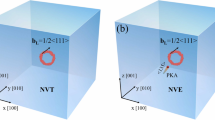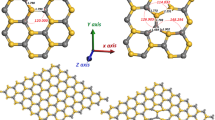Abstract
Atomic defects which migrate and trap at impurity probe atoms can be labelled by the changes they induce in the hyperfine interactions of the probe nuclei. Many studies have been made using perturbed γ−γ angular correlations (PAC) and the111In probe because of the excellent resolution of different sites. Identification of the bound states is the key problem in applying hyperfine interactions methods to point defects studies. In this study three structure-sensitive methods are applied to help identify the atomic structures of various multivacancy complexes in Pt and Au: (1) Quadrupole interaction parameters are compared with results of point-charge calculations of electric-field gradients for 20 structures containing 1–4 vacancies in the fcc lattice. (2) Hyperfine interactions induced by decorating vacancy complexes with hydrogen atoms are measured and interpreted with the assistance of point-charge calculations. (3) Transformations between complexes observed by annihilation of vacancies by mobile self-interstitials are used to test the consistency of the identifications. Using these methods in conjunction with analysis of the trapping behavior which occurs during annealing of damaged samples, structural models are presented for divacancy (2V), 3V and 4V complexes in Pt, and 3V and 4V complexes in Au. The activation temperatures of the 3V defect in Au and Pt are determined to be 162 K and 390 K, respectively, and activation temperatures of defects in Ni, Cu, Pt and Au are compared. For Pt, trapping of H at 1V and 2V complexes is observed to lead to small changes in the quadrupole interactions, consistent with well shielded protonic charges. However, trapping at 3V and 4V complexes leads to very large changes which we attribute to atomic restructuring to the defect complexes. Finally, the application of the same methodology to interpret recent experiments on NiAl, an ordered alloy, is described.
Similar content being viewed by others
References
F. Pleiter and C. Hohenemser, Phys. Rev. B25 (1982) 106.
E. Recknagel, G. Schatz and Th. Wichert, in:Hyperfine Interactions of Radioactive Nuclei, ed. J. Christiansen, Topics in Current Physics, Vol. 31 (Springer, New York, 1983) p. 133.
Th. Wichert, Hyp. Int. 15/16 (1983) 335.
Th. Wichert, in:Characterization of Defects in Materials, eds. R.W. Siegel, J.R. Weertmen and R. Sinclair, Mat. Res. Soc. Symp. Proc., Vol. 82 (1987) 35.
R. Vianden, in:Nuclear Applications on Materials Science, eds. E. Recknagel and J.C. Soares, NATO ASI Series E: Applied Sciences, Vol. 144 (1988) 239.
H.J. Wollenberger, in:Physical Metallurgy, eds. R.W. Cahn and P. Haasen (North-Holland, Amsterdam, 1983) p. 1139.
Vacancies and Interstitials in Metals, eds. A. Seeger, D. Schumacher, W. Schilling and J. Diehl (North-Holland, Amsterdam, 1970).
J. Nuclear Mater. 69/70 (1978).
Point Defects and Defect Interactions in Metals, eds. J. Takamura, M. Doyama and M. Kiritani (University of Tokyo Press, 1982).
Materials Science Forum 15–18 (1987).
R.A. Johnson, J. Phys. F3 (1973) 295.
A.G. Crocker, M. Doneghan and K.W. Ingle, Phil. Mag. A41 (1980) 21.
N.Q. Lam, N.V. Doan and L. Dagens, J. Phys. F: Met. Phys. 15 (1985) 799.
C. Hohenemser, A.R. Arends, H. de Waard, H.G. Devare, F. Pleiter and S.A. Drentje, Hyp. Int. 3 (1977) 297.
M.L. Swanson, L.M. Howe, A.F. Quenneville, Th. Wichert and M. Deicher, J. Phys. F14 (1984) 1603.
M.L. Swanson and L.M. Howe, Nucl. Instr. Meth. in Phys. Res. 218 (1983) 613.
G.S. Collins, S.L. Shropshire and H.-J. Jang, Defect and Diffusion Forum 66–69 (1989) 335.
G.S. Collins, S.L. Shropshire and H.-J. Jang, in:Proc. VIIIth Int. Conf. on Hyperfine Interactions, Prague, August 1989, eds. M. Finger and B. Sedlak, Hyp. Int. (1990) to appear.
M. Deicher, O. Echt, E. Recknagel and Th. Wichert, Hyp. Int. 10 (1981) 667.
S.L. Shropshire and G.S. Collins, in ref. [18].Proc. VIIIth Int. Conf. on Hyperfine Interactions, Prague, August 1989, eds. M. Finger and B. Sedlak, Hyp. Int. (1990) to appear.
H.-G. Mueller, Z. Phys. B47 (1982) 119.
A. Hoffmann, A. Willmeroth and R. Vianden, Z. Phys. B62 (1986) 335.
H.-G. Mueller and H. Hahn, Phil. Mag. A50 (1984) 71.
J. Fan and G.S. Collins, in ref. [18]Proc. VIIIth Int. Conf. on Hyperfine Interactions, Prague, August 1989, eds. M. Finger and B. Sedlak, Hyp. Int. (1990) to appear.
H. Frauenfelder and R.M. Steffen, in:Alpha-, Beta- and Gamma-Ray Spectroscopy, ed. K. Siegbahn, (North-Holland, Amsterdam, 1968).
A.R. Arends, C. Hohenemser, F. Pleiter, H. de Waard, L. Chow and R.M. Suter, Hyp. Int. 8 (1980) 191.
F.D. Feiock and W.R. Johnson, Phys. Rev. 187 (1969) 39.
D. Wegner, Hyp. Int. 23 (1985) 179. Note that the first factor in parentheses in eq. (5b) is incorrect, and should be replaced by (1-η2).
A.R. Arends, C. Hohenemser, F. Pleiter, H. de Waard, L. Chow and R.M. Suter, Hyp. Int. 8 (1980) 191.
G.S. Collins, G. McGhee, S.L. Shropshire, H.-J. Jang, J. Fan and R.B. Schuhmann, in ref. [18].Proc. VIIIth Int. Conf. on Hyperfine Interactions, Prague, August 1989, eds. M. Finger and B. Sedlak, Hyp. Int. (1990) to appear.
G. McGhee, M.S. thesis, Washington State University, 1989 (unpublished).
C. Allard, G.S. Collins and C. Hohenemser, Phys. Rev. B32 (1985) 4839.
G.S. Collins, G.P. Stern and C. Hohenemser, Phys. Lett. 84A (1981) 289.
Th. Wichert, in:Point Defects and Defect Interactions in Metals, eds. J. Takamura, M. Doyama and M. Kiritani (University of Tokyo Press, Tokyo, 1982) p. 19; M. Deicher, O. Echt, E. Recknagel and Th. Wichert in:Nuclear and Electron Resonance Spectroscopies Applied to Materials Science, eds. E.N. Kaufmann and G.K. Shenoy, (Elsevier, New York, 1981)) p. 435; Th. Wichert (private communication).
Th. Wichert, Materials Science Forum 15–18 (1987) 829.
F. Pleiter, W.Z. Venema and A.R. Arends, Hyp. Int. 4 (1978) 693.
M. Deicher, R. Minde and Th. Wichert, Hyp. Int. 15/16 (1983) 401.
G.S. Collins and R.B. Schuhmann, Hyp. Int. 15/16 (1983) 395.
W. Witthuhn, H. Föttinger, D. Forkel, M. Iwatschenko-Bohro, F. Meyer and H. Wolf, Phys. Lett. 119A (1986) 304.
R. Vianden and U. Feuser, Phys. Rev. Lett. 61 (1988) 1981.
G.S. Collins and R.B. Schuhmann, Phys. Rev. B34 (1986) 502.
G.S. Collins, H.-J. Jang and S. Shropshire, in:Nuclear Physics Application on Materials Science, eds. E. Recknagel and J.C. Soares, NATO ASI Series E: Applied Sciences, Vol. 144 (Kluwer, Dordrecht, 1988) p. 415.
K. Zainun, M.S. report, Washington State University, 1989 (unpublished).
S.L. Shropshire, M.S. research report, Washington State University, 1988 (unpublished).
G.S. Collins, C. Allard, R.B. Schuhmann and C. Hohenemser, Phys. Rev. B28 (1983) 2940; and erratum. Phys. Rev. B31 (1985) 2528.
Th. Wichert and M.L. Swanson, Hyp. Int. 23 (1985) 231.
F. Besenbacher, S.M. Myers and J.K. Norskov, Nucl. Inst. Meth. in Phys. Res. B7/8 (1985) 55.
M.J. Puska, R.M. Nieminen and P. Jena, Phys. Rev. B35 (1987) 6059.
K. Post and F. Pleiter, Hyp. Int. 35 (1987) 615.
R.-D. Roitzheim and R. Vianden, in ref. [18].Proc. VIIIth Int. Conf. on Hyperfine Interactions, Prague, August 1989, eds. M. Finger and B. Sedlak, Hyp. Int. (1990) to appear.
J. Trager, M. Karger, T. Butz and F.E. Wagner, Hyp. Int. 15/16 (1983) 795.
A. Weidinger, in:Nuclear Physics Applications on Materials Science, eds. E. Recknagel and J.C. Soares, NATO ASI Series E: Applied Sciences, Vol. 144 (Kluwer, Dordrecht 1988) p. 275.
R.P. Sahu, K.C. Jain and R.W. Siegel, J. Nucl. Mater. 69 & 70 (1978) 264.
A. van den Beukel, in:Vacancies and Interstitials in Metals, eds. A. Seeger, D. Schumacher, W. Schilling and J. Diehl (North-Holland, Amsterdam, 1970) p. 427.
G.R. Piercy, Phil. Mag. 5 (1980) 201.
I. Kovacs and B. Sas, Phil. Mag. 34 (1976) 937.
E. Verbiest, H. Pattyn and J. Odeurs, Nucl. Instr. Meth. 182/183 (1981) 515.
L. Niesen and H. de Waard, Nucl. Instr. Meth. 209/210 (1983) 441.
R.W. Balluffi, J. Nucl. Materl. 69 & 70 (1978) 240.
T.B. Massalski, in:Physical Metallurgy, eds. R.W. Cahn and P. Haasen (North-Holland, Amsterdam, 1983) p. 201.
J. Fan, M.S. report, Washington State University, 1989 (unpublished).
Author information
Authors and Affiliations
Rights and permissions
About this article
Cite this article
Collins, G.S., Shropshire, S.L. & Fan, J. Perturbed γ−γ angular correlations: A spectroscopy for point defects in metals and alloys. Hyperfine Interact 62, 1–34 (1990). https://doi.org/10.1007/BF02407659
Issue Date:
DOI: https://doi.org/10.1007/BF02407659




